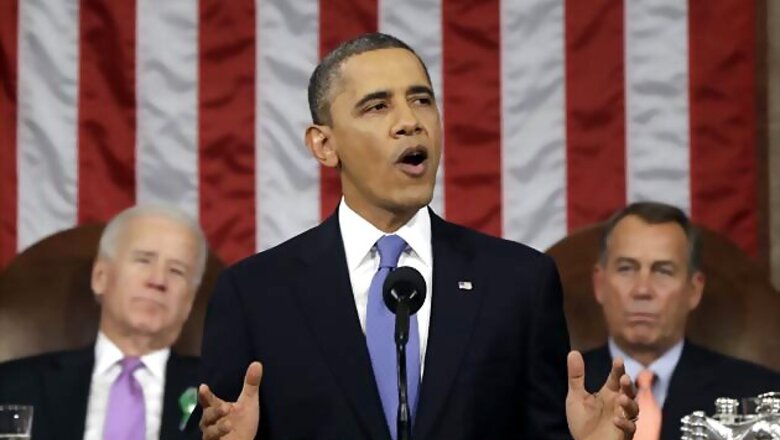
views
Washington: US President Barack Obama said Tuesday he will bring home within a year about half of the 66,000 US troops now in Afghanistan, shrinking the force to the size he found it when he entered the White House vowing to reinvigorate a stalemated war. More will leave the battlefield in 2014, he said, but he did not spell out what US military presence would remain after 2014, when the US-led combat mission is scheduled to end. The stated goal is to prepare Afghanistan's army and police to handle the Taliban insurgency largely on their own by then.
Obama said that his war goals could be achieved by bringing 34,000 US troops home by this time next year, leaving somewhere between 32,000 and 34,000 to support and train Afghan forces. That is about the number in Afghanistan when he took office in January 2009; in a series of moves designed to reverse the Taliban's battlefield momentum, he tripled the total American force before starting to scale it back in the summer of 2011.
Obama's new move, announced in his State of the Union speech, coincides with a major shake-up in his war command. Gen. Joseph Dunford took over Sunday for Gen. John Allen as the commander of all allied forces in Afghanistan, and Defense Secretary Leon Panetta is planning to retire as soon as his replacement is confirmed. Obama has nominated former Sen. Chuck Hagel to take the Pentagon post, and the Senate Armed Services Committee voted 14-11 Tuesday to advance the nomination to the full Senate for a vote possibly later this week.
Without going into specifics, Obama said the phase-out of American combat troops in Afghanistan will continue in 2014. "This drawdown will continue. And by the end of next year, our war in Afghanistan will be over," he said, adding that al Qaeda is no longer the threat it was on 9/11.
"The organization that attacked us on 9/11 is a shadow of its former self," he said. "Different al Qaeda affiliates and extremist groups have emerged - from the Arabian Peninsula to Africa. The threat these groups pose is evolving. But to meet this threat, we don't need to send tens of thousands of our sons and daughters abroad, or occupy other nations."
Obama's decision also reflects Obama's determination to wind down a war that is the longest in America's history. He has many other security problems to consider around the globe - from North Korea's development of nuclear weapons to civil war in Syria to the worrisome spread of al Qaeda affiliated terrorist groups in the Middle East and North Africa.
The White House said the president made his decision about 2013 troop reductions based on recommendations by the military and his national security advisers, as well as consultations with allies such as Britain and Germany and talks with Afghan President Hamid Karzai.
The White House did not spell out the pace at which the 34,000 troops will be withdrawn over the coming year. Defense officials said it's likely that the bulk of them will be kept through summer. The officials spoke on condition of anonymity because details of the withdrawal had not been announced.
Private analysts are divided on the wisdom of accelerating the withdrawal of American forces. Michael O'Hanlon of the Brookings Institution wrote that he believes the current US troop level should remain until autumn, when a seasonal lull in Taliban activity usually begins. "The president should now be patient with what happens over the next eight months," O'Hanlon wrote in an opinion piece for Politico, adding that Dunford needs time to consolidate progress in eastern Afghanistan.
The US is still finalizing plans for the size and scope of its military presence after the allied combat mission ends in December 2014. Stephen Biddle, a professor of international affairs at George Washington University, said the decision on post-2014 force levels is more important than the pace of 2013 withdrawals. "The real issue is what you're ultimately going to draw down to - what does the end of this road look like, not the weigh stations," Biddle said.
Officials have said the White House is considering a range of options that would leave between 5,000 and 10,000 troops beyond 2014, but it also is hoping for help from NATO allies. Those troops would limit their missions to training Afghan troops and hunting down terrorists.
Obama discussed the next phases of the drawdown with Karzai during a meeting in Washington last month, their first since Obama's re-election. They agreed to accelerate their timetable for putting Afghan forces in the lead combat role nationwide, moving that transition up from the summer to the spring.
A persistent worry is that pulling out of Afghanistan too quickly will leave the battle-scarred country vulnerable to collapse. In a worst-case scenario, that could allow the Taliban to regain power and revert to the role they played in the years before 9/11 as protectors of al Qaeda terrorists bent on striking the US
Many Americans, however, are weary of the war, according to public opinion polls, and are skeptical of any claim that Afghanistan is worth more US blood. Registered voters are roughly split between those who say the US should remove all troops and those who favor leaving some troops in place for counter-terrorism efforts, according to a recent Fox News poll.



















Comments
0 comment